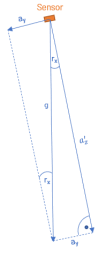Structural Monitoring Without a Budget-Laboratory Results and Field Report on the Use of Low-Cost Acceleration Sensors
- PMID: 40807711
- PMCID: PMC12349514
- DOI: 10.3390/s25154543
Structural Monitoring Without a Budget-Laboratory Results and Field Report on the Use of Low-Cost Acceleration Sensors
Abstract
Authorities responsible for critical infrastructure, particularly bridges, face significant challenges. Many bridges, constructed in the 1960s and 1970s, are now approaching or have surpassed their intended service life. A report from the German Federal Ministry for Digital and Transport (BMVI) indicates that about 12% of the 40,000 federal trunk road bridges in Germany are in "inadequate or unsatisfactory" condition. Similar issues are observed in other countries worldwide. Economic constraints prevent ad hoc replacements, necessitating continued operation with frequent and costly inspections. This situation creates an urgent need for cost-effective, permanent monitoring solutions. This study explores the potential use of low-cost acceleration sensors for monitoring infrastructure structures. Inclination is calculated from the acceleration data of the sensor, using gravitational acceleration as a reference point. Long-term changes in inclination may indicate a change in the geometry of the structure, thereby triggering alarm thresholds. It is particularly important to consider specific challenges associated with low measurement accuracy and the susceptibility of sensors to environmental influences in a low-cost setting. The results of laboratory tests allow for an estimation of measurement accuracy and an analysis of the various error characteristics of the sensors. The article outlines the methodology for developing low-cost inclination sensor systems, the laboratory tests conducted, and the evaluation of different measures to enhance sensor accuracy.
Keywords: MEMS accelerometers; SHM; inclination sensors; low-cost sensors; structural monitoring.
Conflict of interest statement
The authors declare no conflicts of interest.
Figures
















Similar articles
-
Prescription of Controlled Substances: Benefits and Risks.2025 Jul 6. In: StatPearls [Internet]. Treasure Island (FL): StatPearls Publishing; 2025 Jan–. 2025 Jul 6. In: StatPearls [Internet]. Treasure Island (FL): StatPearls Publishing; 2025 Jan–. PMID: 30726003 Free Books & Documents.
-
A rapid and systematic review of the clinical effectiveness and cost-effectiveness of paclitaxel, docetaxel, gemcitabine and vinorelbine in non-small-cell lung cancer.Health Technol Assess. 2001;5(32):1-195. doi: 10.3310/hta5320. Health Technol Assess. 2001. PMID: 12065068
-
Patient Restraint and Seclusion.2025 Aug 6. In: StatPearls [Internet]. Treasure Island (FL): StatPearls Publishing; 2025 Jan–. 2025 Aug 6. In: StatPearls [Internet]. Treasure Island (FL): StatPearls Publishing; 2025 Jan–. PMID: 33351431 Free Books & Documents.
-
Short-Term Memory Impairment.2024 Jun 8. In: StatPearls [Internet]. Treasure Island (FL): StatPearls Publishing; 2025 Jan–. 2024 Jun 8. In: StatPearls [Internet]. Treasure Island (FL): StatPearls Publishing; 2025 Jan–. PMID: 31424720 Free Books & Documents.
-
Automated devices for identifying peripheral arterial disease in people with leg ulceration: an evidence synthesis and cost-effectiveness analysis.Health Technol Assess. 2024 Aug;28(37):1-158. doi: 10.3310/TWCG3912. Health Technol Assess. 2024. PMID: 39186036 Free PMC article.
References
-
- BMVI . Stand Der Modernisierung von Brücken Der Bundesfernstraßen. Bundesministerium für Verkehr und digitale Infrastruktur; Berlin, Germany: 2020.
-
- ASCE . 2021 Report Card for America’s Infrastructure—Bridges. ASCE; Reston, VA, USA: 2021.
-
- ASCE . 2025 Report Card for America’s Infrastructure—Bridges. ASCE; Reston, VA, USA: 2025.
-
- DIN . Bauwerksprüfung Nach DIN 1076—Bedeutung, Organisation, Kosten. DIN; Berlin, Germany: 2013.
-
- Phares B.M., Washer G.A., Rolander D.D., Graybeal B.A., Moore M. Routine Highway Bridge Inspection Condition Documentation Accuracy and Reliability. J. Bridge Eng. 2004;9:403–413. doi: 10.1061/(ASCE)1084-0702(2004)9:4(403). - DOI
LinkOut - more resources
Full Text Sources

